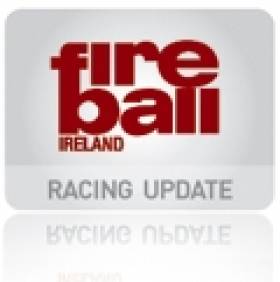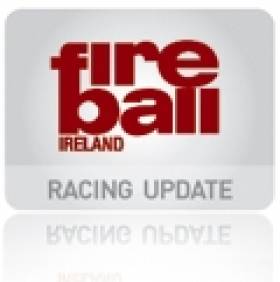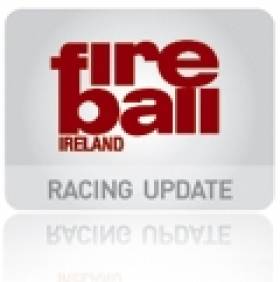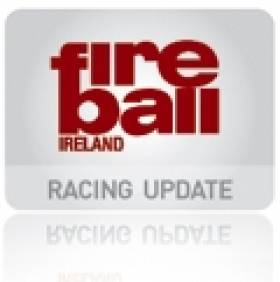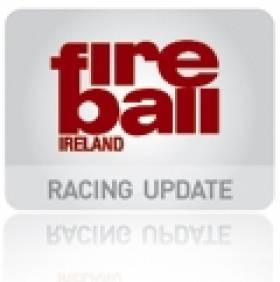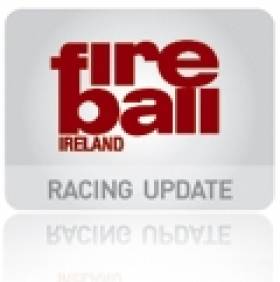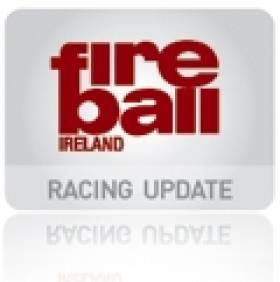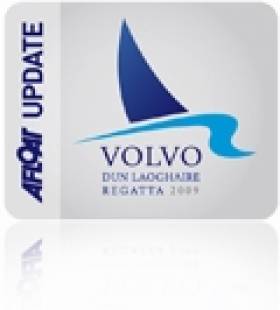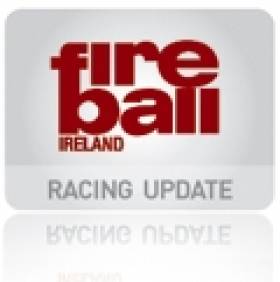Displaying items by tag: Sligo
Lack of Wind, Strong Tide Brings End to International Week
The regatta measuring team were assembled and a further ten boats were measured in for the regatta in a two hour period. As this scribe was part of that team, this report was postponed!
Thus the podium had a distinctly international appeal to it: In first place were Ben Schulz and Phillip Bowley (AUS 15062) who counted four race wins and a second place for their regatta total. In second place were Andy & Derian Scott (GBR 14941) with a 1,2,2,3,3 score line to trail the Aussies by 5pts. In third place, from Canada, were Joe Jospe and Tom Egli (CAN 15024) with a score line of 2,2,4,4,5.
Thereafter there were four Irish boats led home by Noel Butler and Stephen Oram (IRL 15061), Barry McCartin & Conor Kinsella (IRL 14820), Graeme Grant & Hugh Butler (IRL 14807) and Frank Miller and Susie Mulligan (IRL 14713).
A variety of wind conditions had been enjoyed by the fleet over the week with Thursday's racing being the most physically challenging.
The later arrivals in Sligo must have been disappointed at not getting out on the water yesterday but "that's the way the cookie crumbles!"
The assembled fleet was then treated in the evening to a spit roast and a variety of traditional musical groups as part of the coincident Sea Shanty Festival, hosted by the Irish Fireball Class Association as part of the regatta social programme. Next week will see presentations by the Australians for the Mandurah Worlds in December/January and the Italians for the 2012 Europeans. The evening was a great opportunity for friends to catch up as Fireballers from the Shetland Islands, the Czech Republic, France and Germany and the UK arrived at this west coast location on the edge of Europe – Cead Mille Failte (Gaelic for a hundred thousand welcomes)!
Lumpy Day Three at Fireball Pre-Worlds
The Canadians, Jospe & Egli rounded the first weather mark of the day in first place and seemed to enjoy a growing lead as the race wore on, however, at the end the rampant Aussies stole the show again with another win. It seems that on the third beat the Canadian went right, the Aussies went left and left paid. GBR's Alex Taylor and Richard Anderton (15031) joined the fleet this morning and were rewarded with a third place in this race. Derian and Andy Scott were to sail their discard in this race - a 4th – while behind them, another addition to the fleet Ireland's Kenny Rumball and Seamus Moore took 5th, ahead of McCartin/Kinsella and Butler/Oram, the latter combination having spinnaker problems on the downwind leg of the sausage. Elsewhere in the fleet the rivalry between the Ryders, David & Michelle, and Frank Miller/Susie Mulligan went the way of the British couple who scored a 10th to Miller's 18th.Tipton and King (CAN 14907) also had a better race scoring a 9th.
Fortunately the rain showers that had battered the fleet on the way out to the race area at the start of the day were not repeated and the sun decided to shine a bit of the fleet which now boasted 21 boats.
Team Scott led the fleet round the first weather mark in the company of the Aussies, Taylor & Anderton and team Canada. However, on the second reach of the first triangle, Taylor/Anderton took over the lead and proceeded to build a big distance between themselves and the rest of the fleet. Schulz/Bowley took 2nd place, followed by Derian/Andy, Jospe/Egli, Butler/Oram & McCartin/Kinsella. Miller/Mulligan beat the Ryders by a place to leave the pair tied on 45 points each after discard which kicked in on completion of the second race.
The consensus of the fleet was that it had been a very hard day at the office – hardly surprising as we were taking on the Atlantic proper. Today we had rain out on the course a first for this regatta and as per usual the wind had the final throw of the dice as it came ashore.
Today there was the additional attraction of sailing with dolphins and a member of the international jury delayed his return to shore in order to watch them frolic in the water.
Team P&B have now arrived in Sligo as have others who are racing next week – the dinghy park is growing that bit more crowded!
| Overall | Helm | Crew | Sail No |
|---|---|---|---|
| 1 | Ben Schulz | Phillip Bowley | AUS 15062 |
| 2 | Derian Scott | Andy Scott | GBR 14941 |
| 3 | Joe Jospe | Tom Egli | CAN 15024 |
| 4 | Noel Butler | Stephen Oram | IRL 15061 |
| 5 | Barry McCartin | Conor Kinsella | IRL 14820 |
| 6 | Graeme Grant | Hugh Butler | IRL 14807 |
| 7 | Frank Miller | Susie Mulligan | IRL 14713 |
| 8 | David Ryder | Michelle Ryder | GBR 14755 |
| 9 | Cearbhaill Daly | Martina Michels | IRL 14877 |
| 10 | Jonathan Evans | Aidan Caulfield | IRL 14748 |
| 11 | Louis Smyth | Cormac Bradley | IRL 15007 |
| 12 | Guy Tipton | Matt King | CAN 14907 |
| 13 | Alex Taylor | Richard Anderton | GBR 15031 |
| 14 | Louise McKenna | Hermine O'Keeffe | IRL 14691 |
| 15 | Ben Scallan | David Fitzgerald | IRL 14754 |
| 16 | Kenny Rumball | Seamus Moore | IRL 15058 |
| 17 | Patrick Hughes | Aine O'Gara | AUS 14706 |
| 18 | Ben Malone | Matthew Bennion | IRL14939 |
| 19 | Maja Suter | Francois Schlucter | SUI 14921 |
| 20 | David Coleman | Glen Fisher | IRL 14623 |
| 21 | Beth Armstrong | Peter Armstrong | IRL 15060 |
Fireballs Start International Week
In a sad note for the SYC community, Ann Henry, wife of Gus and mother to current Commodore Niall, passed away in the early hours of Sunday morning - a stalwart and rock in the establishment and development of this west coast club. However, in a measure of the contribution the Henry family have made here, both Gus and Niall were present for last night's official opening ceremony.
Pipes and drums from the 26th Infantry Battalion opened proceedings while the flags of the competing countries fluttered in the breeze. Regatta Chairman Brendan Healy welcomed the visitors and members to the Club and introduced the various speakers, Niall Henry, Club Commodore, Niamh McCutcheon, President ISA (National Sailing Authority), Francois Schlucter, Fireball International Commodore and John McClune of Bord Failte who declared the regatta open.
Due thanks were paid to the people who have put in the hours to get the regatta organised and to the sponsors who have made it possible - Dubarry (title sponsors), Marlin Waters, Bord Failte, ISA, Interreg and others.
Once the speeches were over the competitors and officials alike renewed old or made new acquaintances with participants from Australia, Canada, Switzerland, UK and Ireland. The balance of the 9 countries entered for the Worlds will make their way here during the week.
Today will see a small fleet take to the water but the three latest boats in the fleet 15061, 15062 and 15063 are here and ready for action.
Fireball World Champs Makes the News
Monday's Fireball World Sailing Championships got a publicity lift last night when the 58–dinghy sailing event bound for Rosses Point in Sligo made the RTE News bulletin. (See clip below). It's an interesting piece about how a local sailing family, the Armstrong's, have built a home-made boat especially for the event.
The spread of countries heading for the northwest covers Ireland, United Kingdom, Switzerland, Australia, Shetland Islands, France, Czech Republic, Canada and Germany, with the continents being Europe, Australia and North America.
The home contingent boasts 28 boats, followed by GBR with 17 boats, France and Switzerland have three entries each, Canada and the Czech Republic 2, with Australia, the Shetlands and Germany each having one. However, there is a late attempt to get a second Australian entry to the event and in fact with entries being open right up to the eve of the regatta, there is always the prospect that more boats may still declare.
Fireball Worlds Sligo, Two weeks and Counting!
This morning, Friday 27th May, the entry stands at 58 boats, spread across 9 nations and 3 continents. The spread of countries covers Ireland, United Kingdom, Switzerland, Australia, Shetland Islands, France, Czech Republic, Canada and Germany, with the continents being Europe, Australia and North America.
The home contingent boasts 28 boats, followed by GBR with 17 boats, France and Switzerland have three entries each, Canada and the Czech Republic 2, with Australia, the Shetlands and Germany each having one. However, there is a late attempt to get a second Australian entry to the event and in fact with entries being open right up to the eve of the regatta, there is always the prospect that more boats may still declare. I also know of one entry that isn't on the list yet as the crew was only secured last weekend and the boat is still being finished out.
So which names stand out in the entry list thus far?
Tom Gillard and Sam Brearey are the current European Champions having won that title in the Czech Republic in Pavlov last October. They gave a very convincing display in that regatta and have shown good form in the UK regattas they have sailed to date. Tom has also "dabbled" recently in the Scorpion scene in UK with success. Also on the podium in Pavlov was Jaroslav Verner of the Czech Republic who has entered for Sligo with a different crew. From further afield and the sole Aussie thus far, is Ben Schulz, sailing with Phillip Bowley, who finished 5th in the 2010 Worlds in Barbados. Ben is the current Secretary of Fireball Australia.
As the largest Fireball fleet internationally, the UK fleet always brings quality to these events and the entry list for Sligo reflects that continuing trend. Defending champions Chips Howarth and Vyv Townend are not entered, but the British contingent is like a "Who's who" of the class there.
Vince Horey, 11th in Barbados races with Andy Thompson, Matt Burge & Richard Wagstaff, 2nd in Barbados sail together again in Sligo, Simon Potts, 3rd placed crew in Barbados teams up with David Wade, 6th placed helm in Barbados and 6th placed crew in Barbados, Tim Saunders, current UKFA Chairman, teams up with Alan Krailing. For those who follow the Fireball scene in the UK and internationally, these are almost household names!
Messrs Jospe & Egli are perennial competitors at international regattas and they are joined by Messrs Tipton & King. Both combinations contested the Barbados event.
European Commodore Maja Suter is part of a 3-boat Swiss representation which also includes another Fireball stalwart in Ruedi Moser. The French contingent has a similar profile with 3 boats and Jean-Pierre Nouel (Monsieur Cantona) their most travelled competitor.
Of the Irish contingent, the names that will be vying for first home boat will include, on current form, Graeme Grant & Hugh Butler, Noel Butler & Stephen Oram, Barry McCartin & Conor Kinsella and Kenny Rumball & Seamus Moore. Much will depend on the weather, but a 28 boat contingent is great news for the host fleet and bodes well for an interesting session of racing.
Sligo here we come!
Next month's Fireball World Championships at Sligo Yacht Club has announced Irish boating shoe manufacturer Dubarry as title sponsor. The event is expected to attract up to 100 boats from 13 countries. Dun Laoghaire's Noel Butler is expected to lead the home fleet but already new boats are on the scene and doing well at the Fireball stronghold on Dublin Bay. The international jury has been named for the two week event as: Krystyna Lastowska International race officer from Poland, Pam Johnson International Measurer from Great Britain, Tim Went from Australia, Brendan Brogan from Ireland, Keld Stentoft from Denmark, Francois Schluchter from Switzerland, Johan Devocht from Belgium. Click for the latest Fireball news.
More on the Fireball class on the forum here.
Moth Dinghy Makes its Dublin Bay Sailing Club Debut
Making its debut for the first time under the club burgee was an International Moth dinghy. The ultra fast hull was airborne at just eight knots of breeze, making even the trapezing Fireballs look slow. But despite the pace the new fangled dinghy did not feature in the overall Portsmouth Yardstick (PY) results. See below.
A healthy turnout of six 'balls, urged on by the fact that the class World Championships is in Sligo in 46 days time, got some trapezing gusts and some planing waves downwind in a north-easterly breeze of 6-8 knots. S. Oram took the winning gun from Louis Smyth sailing Licence to Thrill.
Single handed Lasers boasted twice the Fireball turnout to be the biggest class racing in Scotsman's bay tonight. It's a show of strength from a class surely worthy of its own start if this kind of turnout can be maintained.
Sean Craig won the Laser race from Peter Craig but the overall PY result went to E. Ryan's RS400.
Two Dublin Bay Mermaids and disappointingly, a single IDRA 14, No.124, Squalls also competed.
DUBLIN PORT Dublin Bay Sailing Club Results for 26 APRIL 2011
FIREBALL - 1. nn (S Oram), 2. Licence to Thrill (Louis Smyth), 3. Incubus (C Power/M Barry)
MERMAID - 1. Lively Lady (G O'Neill & M Hanney), 2. Jill (P.Smith/P.Mangan)
PY CLASS - 1. E Ryan (RS400), 2. Sean Craig (Laser), 3. Peter Craig (Laser)
BENETEAU 31.7 - 1. Extreme Reality (P.McSwiney/E.O'Rafferty), 2. Magic (D.O'Sullivan/D.Espey)
BENETEAU 31.7 - 1. Magic (D.O'Sullivan/D.Espey), 2. Extreme Reality (P.McSwiney/E.O'Rafferty)
CRUISERS 2 - 1. Cor Baby (Keith Kiernan et al), 2. Red Rhum (J Nicholson), 3. Free Spirit (John O'Reilly)
CRUISERS 3 - 1. Grasshopper 2 (K & J Glynn), 2. Pamafe (Michael Costello), 3. Papytoo (M.Walsh/F.Guilfoyle)
CRUISERS 4 - 1. Maranda (Myles Kelly), 2. Ghrazel (Charles Pearson), 3. Artemis (J.Giles)
RUFFIAN 23 - 1. Diane ll (Bruce Carswell), 2. Icicle (C & J Murray), 3. Alias (D.Meeke/M.McCarthy)
SIGMA 33 - 1. Rupert (R.Lovegrove/P.Varian), 2. Pippa lV (G.Kinsman/K.Blake/M.O'Brien)
SQUIB - 1. Tais (Michael O'Connell), 2. Periguin (N.Coakley/J.Redahan)
More DBSC News here.
At the end of every season there is always speculation about who will be buying new boats and what new combinations will be sailing together the following season. The advent of a World Championships heightens that speculation and with the Fireball Worlds scheduled for June 2011 in Sligo, the Irish fleet were the beneficiaries of this fevered activity writes Cormac Bradley.
At the close of the 2010 season the word was that there would be at least one new boat coming into Ireland for 2011. Ironically, the speculation about these individuals' plans has not been resolved because they are not partcipants in the Dun Laoghaire Frostbite Series, coming as they do from the northern side of the Liffey.
Then the word was out of first one and then two new boats, both coming to Dun Laoghaire. Both have now arrived to Stephen Oram and Kenny Rumball respectively. Kenny's boat is still in dry storage (as advised as recently as last Sunday, 1oth April), but Stephen's boat has already taken to the water. Both boats will have numbers around the 15060 mark, as I have seen a photo of 15057 at the Dinghy Exhibition in London in March.
Both boats will be sailed by new combinations. Stephen Oram teamed up with Noel Butler for the Frostbite Series which they won, despite significant on the water competition from Rumball and others. However, it seems the partnership will extend into the 2011 summer season and the Worlds in June. Seamus Moore announced his (premature) retirement from Fireballs after the Barbados Worlds to go running on a serious basis and among his achievements was completing the New York marathon. However, by the time of the 2010 Fireball Nationals, in Baltimore, he was teamed up with Kenny Rumball to finish 2nd overall and they saw out the season in Dunmore East and the Munsters Championships, which they won.
In addition to being very competitive in the Frostbites, the pair were going afloat early on Sunday mornings to get more time on the water. Thus it would appear that they are an "item" for the Sligo Worlds.
Therefore, as the eve of the 2011 regatta season approaches, these two are at the leading edge of the domestic fleet. There are other more established partnerships that will also contest Sligo, Owen Laverty & Ed Butler (Snr), Frank Miller & Grattan Donnelly, Andy Boyle & Brian Flahive among others but none of these have been able to consistently knock Butler/Oram or Rumball/Moore off the winning path.
Over the winter, the most successful Irish Fireballer internationally, outside the aforementioned, in recent times, Francis Rowan, has been conspicuous by his absence. Francis, sailing with red-hot talent from the UK, Tom Gillard (2010 European Champion), was placed third at the 2009 Fireball Europeans in La Rochelle, winning one race, and was placed inside the top ten at the Worlds the following week, again winning a race. To date there isn't a whisper of Francis' 2011 plans.
The domestic season kicked off last weekend, 9/10th April, with Silver Fleet training in Killaloe, organised by Neil Colin. This weekend coming (15/16th April) we have another training weekend with Adam Bowers at the Royal St. George Yacht Club in Dun Laoghaire. Adam is the perennial coach to the British Cadet Class and has coached Olympic aspirants in the 470 Class. He is based in Weymouth, the venue for the 2012 Olympic Regatta which gives his proteges a distinct advantage in the 2012 qualification process. This will be Adam's fourth visit to these shores for training Irish Fireballers and last year's format of coaching at an active regatta, the Leinsters in Howth, was enormously successful. The first regatta of the season will follow shortly therefater, the Leinsters, hosted by Carlingford Sailing Club on the southern shores of Carlingford Lough on 7/8 May. Ex-Fireball Chairman, Ian O'Gorman is the organiser of the event in one of the country's most picturesque locations within very easy driving distance of the greater Dubln area.
Thera are no regattas planned in advance of the Worlds but there will be a reconnaisance in Sligo over the weekend of 21/22 May where we will be joined by Tim Rush of North Sails. This is a revised plan that brings together what was going to be a training weekend by Tim in Dun Laoghaire and a separate visit to Sligo. The absence of regattas is to afford people time for their own individual plans for getting up to speed for Sligo. In a separate assessment of Irish chances at the Sligo Worlds, Noel Butler speculated that two Irish combinations could get into the top 20 in Sligo. At this stage, Butler/Oram and Rumball/Moore would appear to be the leading candidates for those two slots, but the other Irish combinations will be doing their best to upset that particular "applecart" but in a friendly way!
Entries Roll in for Volvo Dun Laoghaire Regatta
Forty entries are already in for Volvo Dun Laoghaire Regatta, a fixture widely expected to be the biggest in Ireland this season when it sets sail on Dublin Bay in July.
Organisers are expecting up to 500 boats to keep it on a par with the 2009 event. The early entries, 11 weeks ahead of the entry deadline, is being taken as a thumbs up by competitors for the fun and vlaue theme of this year's VDLR.
So far 22 different clubs have entered from six countries. The bulk of the fleet is Irish but there are early entries from France, Isle of Man, UK, Wales and Northern Ireland. Another good turnout is exepcted from Liverpool and Holyhead for boats competing in the IRC Lyver Cup Race across the Irish Sea. Ten boats from the Clyde will also compete on the Bay.
Cork's Conor Phelan the skipper of Jump Juice is one of the first Royal Cork boats confirmed.
Two handed IRC racing makes its debut in July's Volvo Dun Laoghaire Regatta organisers have also confirmed. Click HERE.
On the dinghy front, the Fireball class has confirmed it will be running an'Open Championship' within the regatta, an event that follows the class world championships in Sligo in June.
Discount Ferry Fare Scheme for Fireball Worlds in Sligo
Stena Line have confirmed their commitment to the discounted ferry fare scheme for entrants to the 2011 Fireball Worlds in Sligo Yacht Club from across the Irish Sea. Stena generously put in place a similar scheme for 2010 that allowed Irish Fireballers to get to the UK to collect the boats from Barbados and to contest the Fireball Europeans in the Czech Republic.
The scheme will only apply to the crossing of the Irish Sea, with the exception of the Fleetwood – Larne route, and regrettably will not apply to the routes from mainland Europe as Stena operates these in conjunction with other parties.
Access to the preferential fares will be via a dedicated website, using an event code and specific booking information all of which will be provided by the Irish Fireball Association once Stena Line have confirmed their fare structure for the 2011 season.
The website is www.stenaline.ie/event and the booking information will consist of specific words and a dedicated event number.
The only condition attached to this offer is that participants must be able to confirm their entry to the Worlds in documentary form at their ports of departure and arrival, otherwise additional charges will be levied.


























